In Summary
- When conducting swabbing, surfaces should be cleaned, disinfected, and dry.
- Templates to outline the area to be swabbed can be used, especially when you first begin swabbing surfaces.
- There are two types of microbiological tests, qualitative (present or absent) which are typically done to detect pathogens, and quantitative (counted, i.e. cfu/cm²) which are typically done on indicator organisms (like generic E. coli).
- Quantitative tests are more commonly used to assess efficiency of cleaning and sanitation.
- Examples of tests, recommended interpretations, and a step-by-step demonstration of how you can conduct environmental swabbing, are also shown below.
Surfaces to be tested should have been cleaned and disinfected. Surfaces should be dry, flat (whenever possible), smooth and sufficiently large for sample collections. There is no statutory size that has to be used for environmental surface sampling. The UK Food Standards Agency does however recommend using no less than 20cm².
When people begin swabbing environmental surfaces, it is common to use a sterile template to outline the area to be swabbed. Templates can be single-use irradiated plastic or autoclavable steel that can be re-used over a period of years. Common template areas are 50cm² and 100cm². If the sample is to be tested for a potential human pathogen, as large a surface area as is practicable is advised (Willes et al., 2013). It is not uncommon to swab an area of 1000cm² for Listeria monocytogenes testing on food contact surfaces (Griffiths, 2016).
Before deciding what sampling method is appropriate for food contact surfaces, it is necessary to consider the test organism and the reasons for testing. There are two types of microbiological testing undertaken by laboratories, which are qualitative and quantitative testing. Qualitative tests are most common for human pathogens and are typically reported as either present or absent. Quantitative testing reports a count of the numbers of cells present in the sample. In general, the different testing approaches are dependent on how rare the target bacteria are. Human pathogens are rarely detected and have been described as trying to find 'a needle in a haystack' (Griffiths, 2016). Because they are rare, the testing process uses enrichment to try and detect pathogens. Enrichment involves the use of growth media that allows the multiplication of the target bacteria but limits the growth of other non-target bacteria. Because the degree of multiplication of target bacteria during enrichment is unknown, the results are reported as either present or absent. To help find the needle in a haystack, pathogen tests tend to sample large areas, and it might therefore be more appropriate to use a sponge rather than swabs (Griffiths, 2016).
Quantitative testing is commonly (but not exclusively) used to assess the efficiency of cleaning and sanitation. The approach is to estimate the numbers of indicator bacterial cells. A variety of indicators are in use and consideration should be given to which indicator is most suitable. In a high proportion of cases a total count of aerobic mesophiles (TCAM, also commonly called a total viable count [TVC] or most simply a total count) is a suitable indicator. Using TCAM as an indicator is one of the cheapest tests offered by the testing lab, if a pour plate methodology is used. Other common indicators that could be considered for use are shown in Table 1.
| Indicator bacteria | Additional details |
|---|---|
| Thermotolerant E. coli | Growth at ≥42ºC indicates recently deposited faecal material. Growth at ≤25ºC generally indicates the presence of older faecal material. |
| Thermotolerant faecal coliforms | A subset of the Enterobacteriaceae that are associated with the gastrointestinal tracts of humans and animals. Growth at ≥42ºC indicates recently deposited faecal material. Growth at ≤25ºC generally indicates older faecal materials. |
| Enterobacteriaceae | The Enterobacteriaceae are a group of bacterial that includes many species, including E. coli as one example. The group grow at a range of temperatures including enterics (around 40ºC), mesophiles (around 25ºC) and psychrotophs (≤ 4ºC). The Enterobacteriaceae tend to be found growing in rotting vegetation, faeces, water, soil and gastrointestinal tracts. Most of them do not cause illness but where they come from, the environments in which they grow well and the way they die is the same for most foodborne pathogens. Because they come from a range of environmental sources and grow over a range of temperatures, the Enterobacteriaceae are a general hygiene indicator of contamination of more harmful bacteria. The Enterobacteriaceae are widely used to check the microbiological effectiveness of thermal death of bacteria in cooked food. |
| Enterococci | General indicators of faecal contamination |
In addition, regulation 2073/2005 Article 5 Section 2 states that "Food business operators manufacturing ready-to-eat foods, which may pose a Listeria monocytogenes risk for public health, shall sample the processing areas and equipment for Listeria monocytogenes as part of their sampling scheme.", which may be required to be considered for some fresh produce. regulation 852/2004 Chapter III Section 2(c) makes a general statement that "adequate provision is to be made for the cleaning and, where necessary, disinfecting of working utensils and equipment". There are no statutory criteria for numbers of indicator bacteria on surfaces in the fresh produce sector, although there are some limits that exist in other food industries and outside of the EU and these might provide outline guidance for growers when setting their own criteria. Table 2 shows a summary of some criteria.
Table 2 Recommendations and guidance for clean environmental surfaces (adapted from Griffiths 2016).
| Criterium | Reference |
|---|---|
| ≤80 cfu/cm² for TCAM | Herbert et al., 1990 |
| ≤5 cfu/cm² for TCAM | USDA, 1994 |
| ≤10 cfu/cm² for TCAM; ≤1 cfu/cm² for the Enterobactericeae | European Union Meat (Hazard Analysis and Critical Control Point) (England) Regulations 2002/889 |
| ≤2.5 cfu/cm² for TCAM | Mossel et al. 1999 |
| ≤3 cfu/cm² for TCAM | Swedish Food Agency 1998 |
There are a variety of methodologies for the sampling of surfaces that are all referred to as swabbing and there is no universally accepted protocol, although some standard methodologies exist. Common methods involve the use of sponges, wipes and cotton tipped swabs to collect samples. Wet-dry swabbing is a well-established method for the collection of environmental surface samples and is widely used in food processing industries to assess the quality of cleaning and disinfection. The protocol below is one that was authorised by the UK Food Standards Agency as compatible with the instructions contained within the European Union Meat (Hazard Analysis and Critical Control Point) (England) Regulations 2002/889, which was superseded by regulation 2073/2005.
The equipment needed to undertake wet-dry swabbing is shown in the picture below.
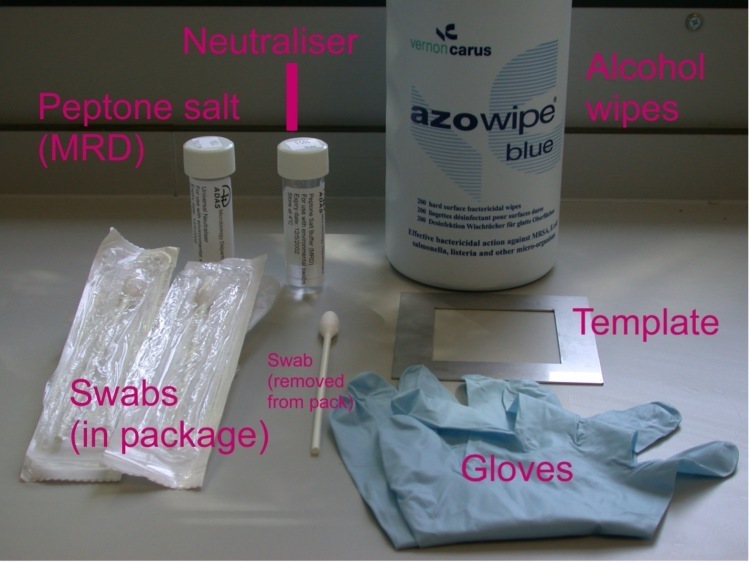
To take a sample, the sampler should wear gloves. Correctly applied gloves help limit bacteria on the sampler's skin from contaminating the samples and increasing the bacterial counts. The sampler's gloved hands should be thoroughly disinfected with an alcohol wipe.
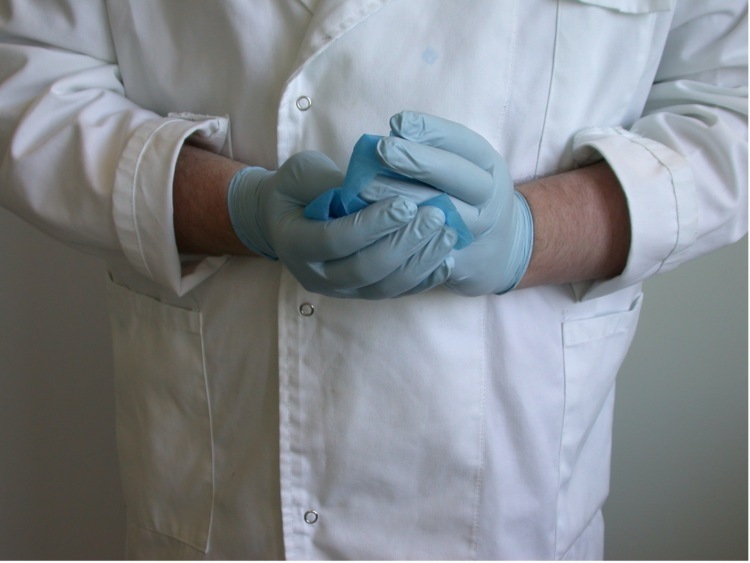
It is best practice to use a template that has been sterilised in an autoclave or by gamma irradiation. However, if the same template is being used for multiple samples, a fresh alcohol wipe can be used to clean and disinfect the template between samples. Any scissors used to cut the swabs should also be sterile.
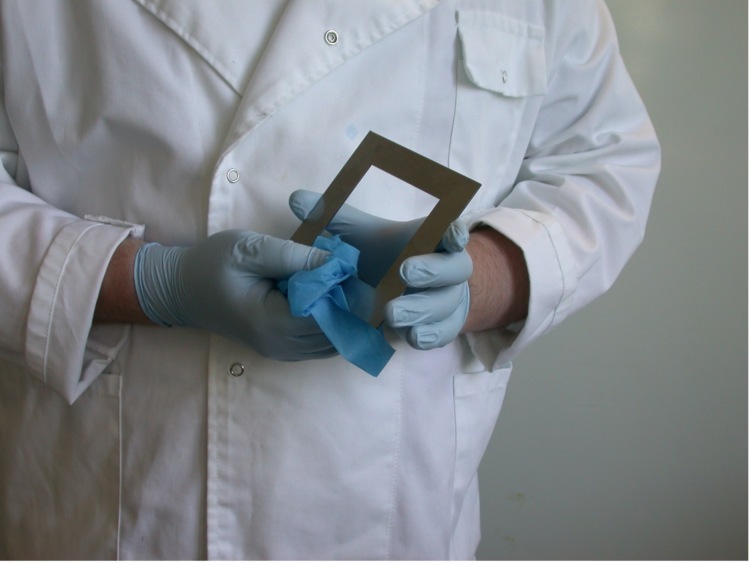
Care should be taken to ensure the templates and other sampling equipment used does not get re-contaminated. Laying the equipment on a fresh alcohol wipe can help prevent recontamination, but the equipment should be visibly dry (i.e. not show a film of residual alcohol) before use.
Two swabs are used to take each sample: one wet, and one dry. The overall idea is that the wet swab coats the surface being sampled and provides a liquid phase for cells from the surface to move into. The applied liquid containing the bacteria is then mopped up using a dry swab.
The sterilised template should be gripped firmly and placed on the surface to be swabbed. The swabs should be rolled between the fingers and thumb to rotate them whilst swabbing.
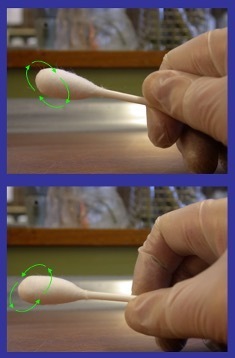
The wet swab should be firmly rubbed (while rotating) across the area within the template. Rubbing must be in three directions; horizontal, then vertical then diagonal as shown below.
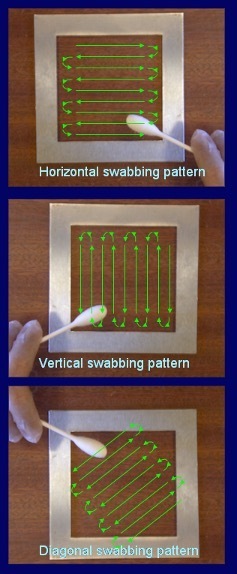
The wet swab is held while the second, dry, swab is used to mop up the liquid. The dry swab is also rolled as it is rubbed across the area within the template, in the same manner as the wet swab, using a horizontal, vertical and diagonal pattern. The dry swab should collect all residual moisture left on the surface by the wet swab.
The ends of both the swabs are cut off (or broken) into a tube of peptone salt solution (peptone salt solution is also called MRD) [maximum recovery diluent] by some labs). Some types of neutraliser can also be used as a medium for transport to the testing laboratory.
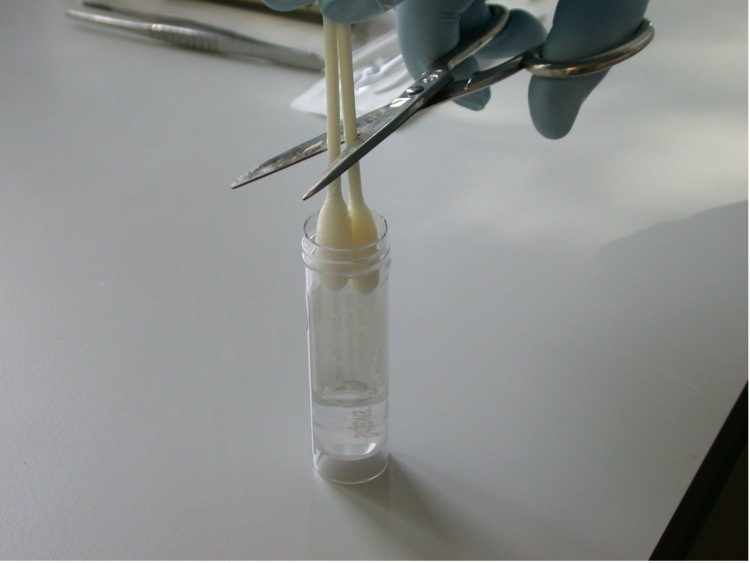
The wet swab is dipped in a neutraliser for at least 10 seconds. The second, dry swab should be kept in its wrapper until required. A neutraliser is used in case there are sanitising chemical residues on the surface being sampled that might kill the bacteria in transit to the laboratory. The neutraliser should be chosen after consideration of the active agents in a disinfectant and the bacteria that will be tested for by the laboratory. Dey Engley broth is called D/E broth or Dey Engley neutralising broth (DENbroth) by some laboratories and is a good, broad-spectrum chemical neutraliser. Common neutralisers and their effectiveness against common disinfectant chemicals are shown in Table 3 below.
| Sanitising chemical | Neutralising solution | ||
|---|---|---|---|
| Dey-Engley Broth | Neutralising buffer | Letheen Broth | |
| Chlorine | Effective | Effective | Marginally effective |
| Gluteraldehyde | Effective | Not effective | Not effective |
| Iodine | Effective | Effective | Marginally effective |
| Peracetic acid/peroxide | Effective | Effective | Effective |
| Phenols | Effective | Not effective | Effective |
| Quaternary ammonium | Effective | Effective | Effective |
The end of the wet swab should be squeezed against the inside of the tube of neutraliser to remove excess neutraliser. Some neutralisers contain low concentrations of nutrients and are suitable for use as a transport medium to the laboratory. However, that is not the case for all neutralisers and if in doubt, the container and the residual neutraliser should be discarded.
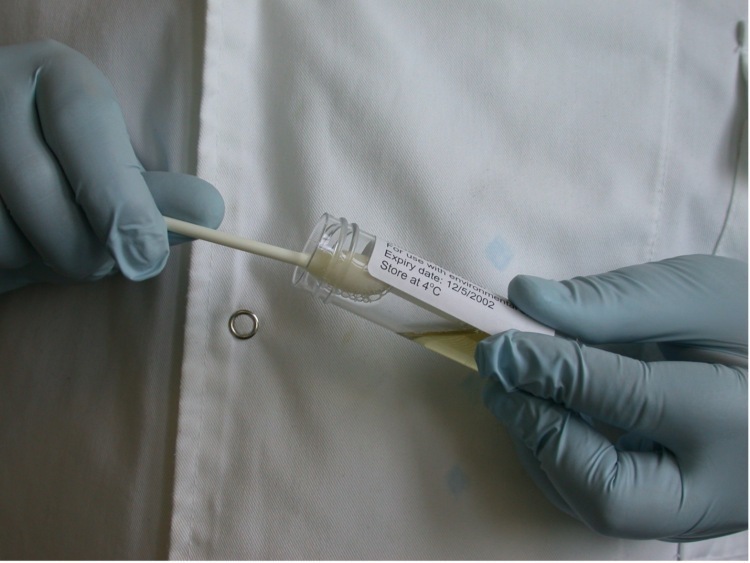
The sample container is sealed and labelled with the date, a description of what was sampled and the size of template used. The size of the area sampled is required by the testing laboratory if reporting of the results is cfu/cm².
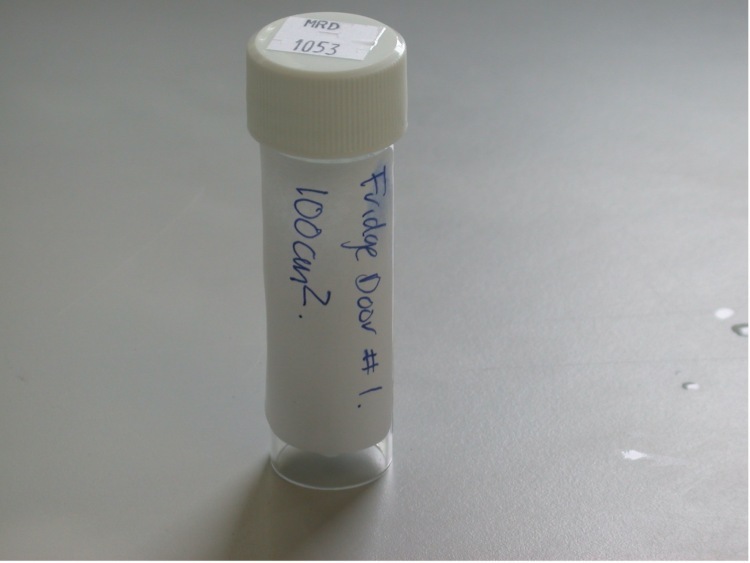
Samples are immediately placed into an insulated cool box containing frozen freezer blocks or crushed ice. The samples must be kept at 0ºC to 4ºC (cold but not frozen). Keeping samples cold prevents bacterial growth, while ensuring they are not frozen prevents bacterial injury. Injured bacteria may be unable to grow when tested at the laboratory. The 0ºC to 4ºC temperature range helps to ensure the counts obtained reflect the levels of bacteria present on the surface. Samples should arrive at the laboratory so that analyses can begin a maximum of 24 hours after being taken.
It is important to note that the neutraliser might contain nutrients that could support bacterial growth. Therefore, the area swabbed requires being recleaned and sanitised so that it does not become a fomite (an object that spreads bacterial contamination) during harvesting or processing.
References
Herbert, M., Donovan, T., Manger, P., 1990. A Study of the Microbiological Contamination of Working Surfaces in a Variety of Food Premises Using the Traditional Swabbing Technique and Commercial Contact Slides. Ashford, Public Health Laboratory Service. This reference is too old to be available electronically.
USDA, 1994. Guidelines for reviewing microbiological control and monitoring programs, part B55, attachment 2. In: Meat and Poultry Inspection Manual. United States Department of Agriculture, Washington, DC. This reference is too old to be available electronically.
Swedish Food Agency, 1998. The Swedish Statute Book. SLV SFS, 10. This reference has been superseded, with recent versions discarding the surfaces criteria. The 1998 version is no longer available electronically.